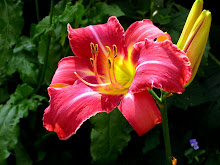
Diehard gardeners usually love to encourage others to get their hands in the dirt, hoping they'll see how rewarding it is. And there’s nothing like a successful experience to really bring pleasure. Which is why it breaks my heart a little whenever I hear of a gardening “failure” that could have been avoided … like the folks I know who planted their veggie seedlings out waaaaay too early last spring, and lost them all to frost; or the rose bush planted in such poor soil that it conked out pretty quickly. Heaven knows I’ve made plenty of mistakes myself over the years … or, perhaps I should say, I’ve had plenty of learning experiences.
And so, instead of harping on why you should plant daylilies that are 1) purchased from a grower in or near your climate zone, and/or 2) known to be good performers in your part of the world, here’s a visual aid to illustrate the point.
Several years ago, I ordered several daylilies that I knew were northern-hardy from a southern grower. Along with my order, they included a bonus … one of their newer hybridized introductions, which lists for $75 in their catalog. Wow!, I thought, that’s amazing! -- I figured it would be quite special.
Here we are, three years later. You can see that the daylilies on the left and right have normal-sized foliage for this time of year; and you can see that the ones in the center are small, thin, and grass-like. That is the three-year-old “clump” of the $75 introduction, a Zone 5-inappropriate daylily, bred to live in the South. Oh, it survives here … barely. Last year it threw up only one blossom. If I didn’t know the reason, I would have been tremendously disappointed … and if I had spent $75 for the plant, I would feel even worse.
So buy what will thrive where you live. Spend wisely. Be happy. And have a beautiful garden!






